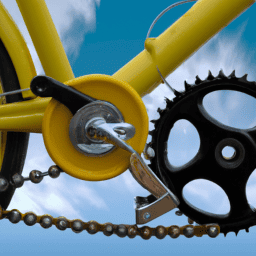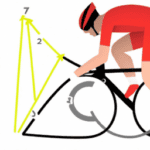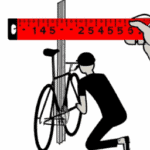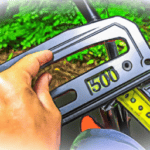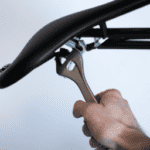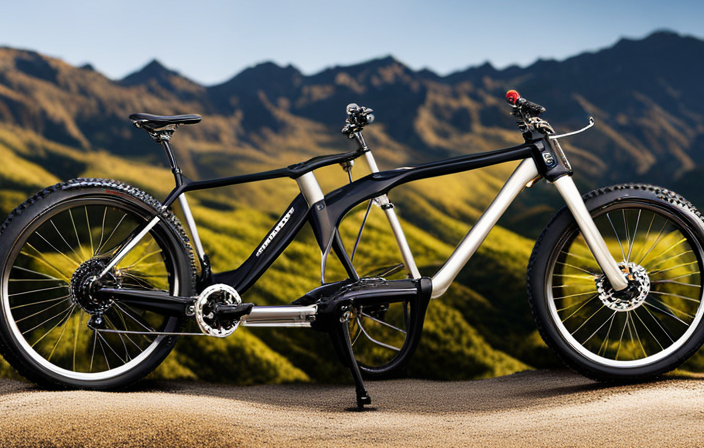For cyclists, the height of their bicycle seat plays a crucial role in their comfort and performance while riding. If the seat is set either too high or too low, it can result in discomfort, pain, and potentially cause injuries.
Finding the proper height for your seat is essential to ensure that your body is properly aligned and your pedaling motion is efficient.
To determine the correct height for your bicycle seat, several factors need to be taken into consideration. These include your inseam length, riding style, and personal comfort preferences.
In this article, I will provide you with a step-by-step guide to measuring your inseam, determining your riding style, and adjusting your seat height accordingly. By following these guidelines, you can find the optimal seat height for your body, allowing you to ride comfortably and efficiently for hours on end.
Key Takeaways
- Proper seat height is important for comfort and performance while cycling.
- Factors to consider when determining seat height include inseam length, riding style, and personal preferences.
- Adjust seat height to ensure a slight bend in the knee when the pedal is at its lowest point.
- Proper seat height improves power and speed, reduces the risk of injury, and increases comfort on long rides.
Understand the Importance of Proper Seat Height
Are you tired of experiencing discomfort and pain while cycling? Well, it’s time to understand why having the proper seat height is crucial for your riding experience.
One of the most significant benefits of having the correct seat height is the importance of posture. When your seat is too low or too high, it can cause you to hunch over or stretch out too far, leading to poor posture. Poor posture can lead to discomfort, pain, and even long-term injuries such as back pain or joint problems.
Another advantage of having the correct seat height is preventing injuries. When your seat is too low, it can cause your knees to bend too much, leading to knee pain. On the other hand, when your seat is too high, it can cause your hips to rock side to side, leading to hip pain.
By having the correct seat height, you can prevent these types of injuries and enjoy a more comfortable ride. Now that you understand the importance of proper seat height, let’s move on to measuring your inseam to determine the correct seat height for you.
Measure Your Inseam
To get the right fit for your bike, you’ll want to measure your inseam – did you know that the average inseam length for men in the US is 29 inches?
To do this, stand with your back against a wall and place a book between your legs, as if you were sitting on a saddle. Measure from the floor to the top of the book to determine your inseam length.
Once you have this measurement, you can use it to determine the appropriate seat height for your bike. Choosing footwear is also important when it comes to finding the right seat height.
You’ll want to wear the shoes you normally ride in when measuring your inseam to ensure accuracy. Additionally, stretching exercises can help improve flexibility and make it easier to reach the pedals comfortably.
Incorporating exercises such as hamstring stretches and hip flexor stretches into your routine can make a big difference in your riding comfort. With the right inseam measurement, footwear, and stretching routine, you’ll be well on your way to finding the perfect seat height for your riding style.
Determine Your Riding Style
Discovering your riding style is key in finding the most comfortable position on your bike. The two main types of cycling are mountain biking and road cycling, each requiring different riding positions.
Mountain biking is more aggressive and requires a more upright riding position with a lower seat height to allow for more maneuverability on rough terrain. On the other hand, road cycling requires a more leaned forward position, with a higher seat height to allow for maximum pedal efficiency and aerodynamics.
In addition to the type of cycling, your riding style also plays a role in determining your seat height. Recreational riders may prefer a lower seat height, allowing for a more relaxed and comfortable ride. On the other hand, competitive riders may prefer a higher seat height to maximize power output and speed.
Understanding your riding style is crucial in finding the most comfortable and efficient position on your bike. With this knowledge, you can now adjust your seat height accordingly to achieve your optimal riding position.
Adjust Your Seat Height
Once you’ve determined your riding style, adjusting your seat height can make all the difference in achieving a comfortable and efficient ride. Finding the optimal position for your seat can help prevent knee pain and posture correction.
Here are some tips for adjusting your seat height:
-
Start with a level seat: Make sure your seat is level to the ground. This will ensure that your weight is evenly distributed on the bike.
-
Measure your inseam: Stand with your feet shoulder-width apart and measure the distance from the ground to your crotch. This will give you a starting point for adjusting your seat height.
-
Adjust seat height: Loosen the seat clamp and adjust the seat to the desired height. The ideal seat height is when you can pedal comfortably with your leg almost fully extended at the bottom of the pedal stroke.
-
Test and refine: Take your bike for a test ride and adjust the seat height as needed. You should feel comfortable and stable while riding.
By adjusting your seat height, you can achieve the optimal position for your body and prevent discomfort while cycling.
In the next section, we’ll discuss how to test and refine your seat height for the best riding experience.
Test and Refine Your Seat Height
When it comes to adjusting your bicycle seat height, it’s important to pay attention to your comfort level while riding.
As you begin to ride more frequently, it’s also important to monitor your performance and how your body is responding to your seat height.
Making adjustments as needed can help you achieve optimal comfort and performance on your bike.
Pay Attention to Comfort
Comfort is key when adjusting your bicycle seat height. Proper posture on the bike can be achieved by finding a seat height that allows for a slight bend in the knee when the pedal is at its lowest point. However, finding the perfect seat height goes beyond just achieving proper posture.
It’s important to pay attention to any discomfort or pain that may arise during your rides, particularly saddle soreness. Adjusting the seat height can help alleviate any discomfort, but it’s important to find the balance between comfort and proper posture.
During your rides, pay attention to how your body feels and any discomfort that may arise. If you experience any saddle soreness or discomfort, it may be a sign that your seat height needs to be adjusted. Finding the right seat height can help improve your comfort and overall performance on the bike.
In the next section, we’ll discuss how to monitor your performance and make any necessary adjustments to your seat height.
Monitor Performance
As you pedal along, keep a close eye on how your body responds to different seat heights and adjust accordingly for optimal performance and comfort. Monitoring your performance is key to tracking progress and setting goals.
Pay attention to how your body feels as you pedal and make note of any discomfort or strain you may feel in your knees, hips, or back. If you find yourself struggling to maintain a consistent pace or feeling fatigued after a short distance, it may be a sign that your seat height needs adjusting.
Start by making small adjustments and test how your body responds. Remember, finding the right seat height is a process and may require some trial and error. Make adjustments as needed to ensure that you are comfortable and performing at your best.
Make Adjustments as Needed
Now that you’ve been monitoring your performance on your bicycle, it’s time to make adjustments as needed to ensure that you’re getting the most out of your ride. One of the most important adjustments you can make is to ensure that your bicycle seat is at the proper height. This will not only improve your performance, but it will also prevent injury and discomfort.
Common mistakes when it comes to adjusting your bicycle seat height include setting it too low or too high, which can result in knee pain, lower back pain, and an inefficient pedal stroke. Expert advice recommends adjusting the seat height so that your leg is almost fully extended at the bottom of the pedal stroke, with a slight bend in the knee. This will ensure that you’re using your leg muscles efficiently and effectively. The benefits of proper seat height include improved power and speed, reduced risk of injury, and increased comfort on long rides.
| Common Mistakes | Expert Advice | Benefits of Proper Height |
|---|---|---|
| Setting the seat too low or too high | Adjust the seat height so that your leg is almost fully extended at the bottom of the pedal stroke, with a slight bend in the knee | Improved power and speed, reduced risk of injury, increased comfort on long rides |
So take the time to adjust your bicycle seat height properly, and reap the benefits of a better ride. Not only will you be able to ride longer and faster, but you’ll also be doing it with greater ease and comfort. Remember, a little adjustment can go a long way in improving your cycling experience.
Frequently Asked Questions
What are the consequences of riding with an improperly adjusted seat height?
Improperly adjusted seat height can lead to knee injuries due to incorrect leg extension and improper posture. It’s important to ensure correct saddle height for optimal performance and comfort while riding.
How can I measure my inseam accurately?
To measure my inseam accurately, I stand barefoot against a wall with a book held snugly between my legs and measure from the floor to the book’s top edge. Common mistakes to avoid include wearing shoes or placing the book too high.
Is it necessary to adjust my seat height for different types of riding, such as commuting versus mountain biking?
Adjusting seat height based on riding type can improve performance and comfort. Proper seat height optimizes leg extension, reducing fatigue and injury risk. Adjust seat height for commuting, mountain biking, and other activities to reap the benefits of proper fit.
Can I adjust my seat height on my own, or do I need to take it to a professional?
I’ve found that making DIY adjustments to my bike’s seat height is possible, but can be tricky. It’s important to understand the proper techniques to avoid damaging the bike or causing injury. For more complex tuning, seeking help from a professional is recommended.
How often should I check and adjust my seat height?
It’s important to regularly check and adjust my bike seat height for optimal benefits. I recommend doing so every few rides to ensure proper positioning and prevent discomfort or injury.
Conclusion
In conclusion, finding the proper height for your bicycle seat is crucial for enjoying a comfortable and efficient ride. As I’ve learned through my own experience, measuring your inseam and determining your riding style are important factors in determining the right seat height for you.
Adjusting your seat height may take some trial and error, but it’s worth it to achieve the perfect fit. Remember, "measure twice, cut once"- take the time to make sure your seat height is correct before hitting the road.
It’s also important to note that a proper seat height can prevent injury and improve your overall performance. So, whether you’re a casual rider or a serious cyclist, don’t underestimate the importance of having the right seat height.
Keep these tips in mind and enjoy a comfortable, efficient ride.

